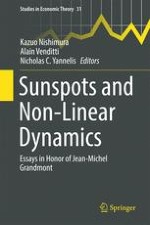2017 | OriginalPaper | Chapter
14. Nonbalanced Growth in a Neoclassical Two-Sector Optimal Growth Model
Author : Harutaka Takahashi
Published in: Sunspots and Non-Linear Dynamics
Publisher: Springer International Publishing
Activate our intelligent search to find suitable subject content or patents.
Select sections of text to find matching patents with Artificial Intelligence. powered by
Select sections of text to find additional relevant content using AI-assisted search. powered by
